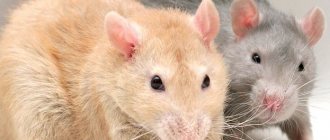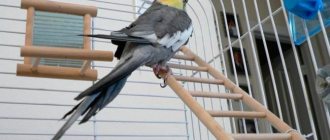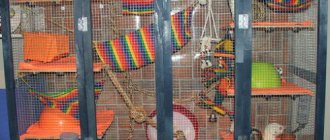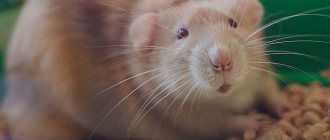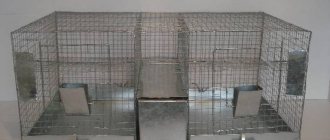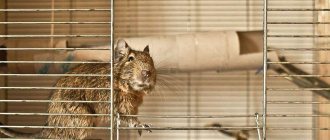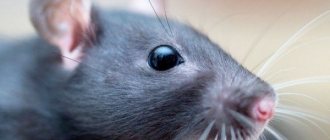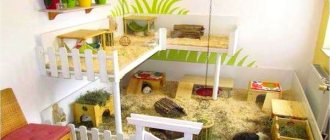We choose the right, comfortable and safe cage for the rat. Mandatory points to consider when choosing. What you need to know about arranging a cage. What mandatory accessories and items should be present in a pet’s home.
When purchasing a pet, we want to create the most comfortable living conditions for it. If you are planning to purchase a decorative rat, you should take care of its housing in advance. Next, we will look in detail at what a rat cage should be like, where to install it, what mandatory accessories should be in it, and how to properly organize the space.
Features of the cell
A cage serves as housing for a decorative rat. It is worth understanding that the animal will spend quite a lot of time in it, sleeping, eating, playing, relaxing, so such a home should be quite spacious, comfortable, and, of course, safe.
Some owners let the rodent roam freely around the apartment, this is an advantage in terms of the animal’s freedom, since it is not limited in its actions, but it must have personal space, a corner where it will feel like an owner, confidently and calmly.
What structures cannot be used
Many rat breeders mistakenly believe that any jar or box is suitable for small animals to live in. However, it is not. To protect your furry from stress and discomfort, you should not place your pet in the following types of housing:
- Glass jars, aquariums and terrariums - such containers have solid walls, so soon after moving in the rat will feel a severe lack of air. There are many examples of rodents simply suffocating in aquariums.
- Carton boxes. The rat will run away from such a dwelling at the first opportunity. In addition, air exchange in boxes is also difficult.
- Plastic containers are only suitable for keeping the rat inside temporarily, for example during transport. Because after 30-40 minutes the animal will also begin to suffer from a lack of oxygen.
Also, you should not choose low cages designed for keeping mice or small hamsters as a home for a rat. Rats are quite freedom-loving, so they do not do well in confined spaces.
Which cage should you choose?
These are quite large rodents that lead an active lifestyle, love to play and frolic. The cage must be of sufficient size so that the animal does not live in cramped conditions. The tray must be at least 10 cm, so the filler, even during the most fun games, will remain in the middle and not scatter around the room. Rats are very clean, so you should choose a home that is easy to clean.
Pay attention to the material of the pallet; wood and metal are not suitable. Wood becomes deformed after getting wet, and metal rusts, so such products will quickly become unusable. The most suitable option is durable plastic.
This material is not affected by water and moisture, it also does not absorb odors, which is very important, and is easy to clean. When choosing, you need to carefully inspect the pallet so that there are no chips or cracks, and there should also be no chemical smell. But the bars should be metal, pay attention to the distance between them so that the animal cannot leave its home on its own.
How to play and train a decorative rat
Everyone knows that domestic rats have a fairly high level of intelligence. For the normal functioning of the animal, it is necessary to find time for communication and long walks. The domestic rat is happy to make contact with humans
During the walking process, it is very important to provide the animal with physical activity, spending time with energetic and fun games
Pets will easily chase after some object on a string, climb in the sleeves and bosom of the owner, play with boxes in the drawer, taking them out of it, etc. All this should happen accompanied by laughter, encouragement, and petting. This must be done constantly so that the pet rat does not lose the habit of its owner, without ceasing to trust him, like the rest of the family.
These animals can be easily taught to perform simple tricks, but this must be done regularly, otherwise a positive effect is unlikely to be achieved. You need to be persistent and after each successfully performed trick the animal should receive a treat. Under no circumstances should you raise your voice, much less beat an animal.
10 RULES FOR DEALING WITH RATS! DECORATIVE RATS: MAINTENANCE AND CARE!
Watch this video on YouTube
Cage size
The larger the animal’s home, the more comfortable it will feel. Regarding the minimum dimensions, they should be at least 60 x 40 cm, and at least 50, 60 cm in height. Such a dwelling is enough for one, maximum two rodents. The more animals there are, the larger and taller the cage should be.
If a pair of animals is purchased, same-sex representatives must be placed in one cage, two girls or two boys; conflicts may arise among opposite-sex couples.
There are a variety of cages on sale that differ not only in tray height and size, but also in design. Experienced breeders recommend purchasing double-tiered designs for girls, as they are much more active.
In a cage, the animal should feel free, where there is an opportunity to lie down and stretch out, stand on its hind legs and not touch the upper bars with its head. Of course, it is worth considering the size of the room in which the cage will be placed. It should not interfere with family members, so that they do not trip over it or move it from place to place.
Some owners buy small cages for little rats, and as they grow older, they look at other options. Such acquisitions are not very profitable; rodents grow quite quickly.
A sedentary lifestyle is contraindicated for animals and can cause obesity and other diseases. Not having enough free space can affect his character and cause irritability.
What to look for when choosing a rat cage
A good cage should provide rats with a safe living environment in which all their physiological needs will be taken into account. I have highlighted the key points that you need to pay attention to when choosing. Using the information presented below, you can easily distinguish a good model from a bad one.
Cell type
The best option for keeping rats is a classic cage with a plastic tray and metal bars. Aquariums and plastic dunes are not suitable as permanent housing due to poor ventilation.
Dimensions
The size of the base should be no less than 60x40 cm, and the height should be no less than 50 cm. This is enough to fully support 1-2 rats. If you plan to have three or more rats, each of them should have about 50 liters of internal volume.
Rods
The ideal distance between the bars of the cage should be 1 centimeter, the maximum permissible for adult rats is 1.7 cm (2 provided that large males are kept in the cage.) The grid itself serves as an additional sports equipment for climbing, so it is desirable that the bars are positioned horizontally.
Rod options
So, as we have already figured out, the rods must be metal, but it is very important whether they are galvanized or painted. Galvanized ones are subject to corrosion, which is impractical and even dangerous; painted ones are durable and will last a long time.
Remember that the rods must be securely welded and always have a rounded shape. For small rats, the distance between the rods should not exceed 0.7-1 cm, and for adults 1.2-1.5 cm.
Types of decorative rats with photos
There are several breed types of decorative rats, which people take great pleasure in keeping in their homes, to the delight of their relatives.
Standard
The most common breed of decorative rats, which is the ancestor of other varieties. It is distinguished by a compacted and elongated body, smooth coat, wide ears and a long tail covered with sparse hairs.
Dumbo
It has a cute and unique appearance. Due to the presence of relatively large and protruding ears, the rodent's muzzle has a very funny appearance. The little rat got its name because of these protruding ears, which are very similar to the ears of the eponymous baby elephant Dumbo, invented by Disney directors.
Rex
An equally popular variety of domestic rodent. A characteristic feature of the animal is that this rat has wavy fur. Because of this feature, the animal looks more like a living plush toy.
Sphinx
The breed can truly be considered unique, since the animal has no fur, with the exception of rare hairs covering the upper part of the body. Rodents have folded skin of a pale pink hue, which gives the animal some tenderness, although this breed is more for lovers and not everyone is ready to keep this animal at home. On the other hand, this is an excellent option for those who suffer from allergies.
Satin
This breed is very popular among owners in European countries. It is distinguished by a unique, shiny, satin-like coat. This uniqueness is the determining factor that contributes to the great demand for the animal.
Tailless
This rodent lacks a tail, which is how the rodent got its name. The animal has a pear-shaped body. With all this, these factors do not negatively affect the popularity of this breed.
Types of decorative rats | Pet rats
Watch this video on YouTube
Pros and cons of different types of housing for rats
Next, we will look at the advantages and disadvantages of different types of housing; comparative characteristics will show why cages are recommended for keeping rats and are the best option.
| Kinds | Aquarium/terrarium | Plastic container/cage | Cell |
| pros | Closed walls that prevent the filler from crumbling. | Indispensable when you need to temporarily remove an animal from its permanent home. | Inexpensive, easy to clean, enough air, comfortable for animals. |
| Minuses | There is no natural air ventilation. | Can only act as temporary housing. | Incorrectly selected sizes and distances between the rods can cause maintenance problems. |
Choosing the right litter for rats
Using the wrong litter for rats can have a very negative impact on their health. Wood shavings or sawdust can be extremely harmful to your rats' skin and respiratory tract and can also cause an allergic reaction.
Filling materials that are safe for rats:
- Finely chopped, shredded paper;
- Shredded cardboard suitable for the base of the cage;
- Hemp is odorless;
- Cardboard squares are about 1 cm in size, ideal for the base of the cage;
- Fleece or towels can be used in sleeping areas or as hammocks;
- Paper granules.
What is the price?
Everything will depend on which option you prefer. Small cages are cheaper, but they are usually purchased for small rats. Large, spacious models are more expensive, also double-tiered.
The most expensive models include cages that are fully equipped for housing. They are often equipped with feeders, drinking bowls, hammocks, ladders, horizontal bars, and houses. Such an acquisition will be profitable and very convenient for beginning breeders who do not yet know how to properly organize the space and equip it with everything they need.
Choosing a place in the house to place the cage
When choosing a place for a cage in the house, you need to adhere to the following basic principles:
- no drafts, the cage should not be located close to the air conditioner;
- the room where the cage is located must be ventilated daily;
- the room should be dry (recommended humidity 50%), strong humidity can negatively affect the health of pets
- the room should be quite warm, but not hot. A comfortable temperature for mice is about 20°C; a sufficiently strong increase in temperature (including close proximity to heating devices) can lead to the death of the animals;
- the room should be light.
You cannot place the cage on the floor or windowsill. It is best to equip a special rack. As for the desire of the owners to provide more light to the animals or give them the opportunity to “breathe fresh air” by taking them out onto the balcony or placing the cage near an open window, these are also very bad ideas. Wind and direct sunlight can play a sad role in the lives of small creatures.
DIY cage
Different situations happen, and owners may simply not find a decent housing option for their pet. Some continue to search, and some decide to make a home for the animal with their own hands.
Regarding the advantages of such products, it is worth noting that the owner chooses the type of structure, its dimensions, the presence of a pallet, and design. But there are also disadvantages: at first glance, a simple design, in fact, it has many nuances and they will need to be taken into account.
The person who will be engaged in manufacturing must have at least minimal skills in working with such products. You will need to create a drawing, purchase the necessary materials and tools, show your imagination, and spend time. It’s worth thinking through everything in advance and weighing the pros and cons; perhaps it’s easier and simpler to spend a little time searching and purchasing the right model.
Working with galvanized mesh
In addition to the frame, the rat cage must also contain a lattice, which, in fact, will keep the animal locked up. Otherwise, the apartment of the happy owner will be in chaos and destruction. Just like any house, a cage consists of four walls, a floor and a ceiling. Almost everything except the pallet will be created from galvanized mesh. And this means that you have to work hard. First you need to mark the walls. They should be as tall and wide as a frame. That is, everything should fit together perfectly. The marks have been set - let's get to work. To cut the mesh accurately, you need good and sharp tools.
Wire cutters are suitable for this task. Galvanized mesh must be cut step by step, section by section. You constantly need to measure what is cut off: parallel walls must be the same. Otherwise, the cell will bend in different directions like a wave. But this will not increase comfort in any way, and the appearance will be sloppy. Well, if the walls are already cut, they should be prepared for further use. First, sand down all edges, tips and nicks. Protruding shoots should also be removed. Sanding work can be done with sandpaper. He will do this task well. Secondly, the cut galvanized mesh needs to be painted. This will protect the cage from rusting and from quickly losing its presentation. You can paint the mesh with regular enamel.
How to arrange your home
One of the most important points is the arrangement of the cage, and the main thing here is to avoid mistakes, since this can affect the animal’s behavior, character, well-being and even health. The very first thing is to purchase a filler; it is better to give preference to natural materials.
You will also need to install in the cage:
- Feeder. You can use a small bowl, but keep in mind that rodents are very active and can turn over dishes with food. The right thing to do would be to buy a special bowl with fasteners.
- Drinking bowl. Animals are not very careful with water, they can spill it, climb into it with their paws, for this reason food and filler get into it, it is better to install 2 drinking bowls.
- Hammock. It is not a mandatory accessory, but if you install it, the little animal will be very grateful, since they love this item very much, they crawl onto it, pull themselves up on it, hide from the light, and sleep. This is perhaps the most popular accessory that rats really love.
- Little house. It serves as a place where a pet can hide if he is tired of excessive attention, take cover when he is scared of something, be alone or just sleep in a cozy house.
- Toilet. These animals are very clean and, if a toilet is installed, they will not necessarily go to it to keep the area clean. A small ceramic container or corner tray can serve as a toilet.
- Shelves. The shelves will act as sports equipment; they will allow the rat to easily observe those around him, jump, and pull himself up. They should be installed on different tiers, the distance between them should be about 15-20 cm. The shelves should be securely fastened so that the animal does not get injured.
Rating of TOP 6 cages for rats
After analyzing the domestic pet products market, I selected the best offers presented there, analyzing in detail both the advantages and disadvantages of each model.
InterZoo Teddy Gigant G089
Compact cage from a famous Polish brand, made of non-toxic plastic and stainless steel. Galvanized rods. A version with an enamel grille is also available.
The cage has good build quality. The distance between the rods is 1 cm, which will allow you to keep the cubs in it without fear of their escape. The doors are equipped with secure locks that can only be opened from the outside. The delivery set includes 3 shelves and ladders made of multi-colored plastic, a house, two bowls, two running wheels.
| Dimensions (Length*width*height) | 58*38*55 cm |
| Additional accessories | Floors, bowls, wheels, house |
| Distance between rods | 1 cm |
| Weight | 3.8 kg |
| Maximum number of rats | 2 |
Price
from 4400 to 5500 rub.
- compact;
- affordable price;
- safe for animals;
- horizontal rods are convenient for climbing.
- not suitable for more than 2 pets;
- Running wheels are useless when keeping rats.
- older animals may require a larger house.
Large cage, made of quality material. The location of the doors is well thought out, there are 3 of them. The shelves (there are also 3 of them) can be arranged at your discretion. A tall tray that is simply and easily removed.
InterZoo Teddy Gigant G089
Ferplast Jenny
The product from the Italian brand Ferplast is one of the best in its class. The cage has a thoughtful design and is made of safe, non-toxic materials. The grille is non-separable, the bars are horizontal. The distance between them is 0.8 cm, which makes the model a suitable option even for newborn rats.
The cage has front, side and top doors. A reliable locking mechanism will prevent pets from accidentally opening them from the inside. The cage comes with a transparent tunnel, two plastic floors, a solid ladder, a metal bowl and an automatic drinker.
| Dimensions (Length*width*height) | 80*50*79.5 cm |
| Additional accessories | Floors, bowl, drinking bowl, stairs, tunnel |
| Distance between rods | 0.8 cm. |
| Weight | 9.2 kg |
| Maximum number of rats | 5-7 |
Price
from 14200 to 16500 rub.
- roomy;
- excellent build quality;
- the high sides of the pallet prevent filler from getting onto the floor;
- The metal bowl is resistant to attempts to chew it.
- small doors.
One of the advantages is that the cage is quite spacious and light, but it fits into the bathroom with difficulty. It's not difficult to wash. The distance between the bars is small, even a little rat won't get through.
Ferplast Jenny
Savic Freddy 2
An excellent cage from the Belgian company Savic. Designed for keeping rats, degus, and other small and medium-sized rodents, can be used as a home for ferrets. It is quite roomy, but does not take up much space in the house. Made from high quality, animal-safe materials.
The high tray allows you to keep the room clean. The grille is fixed with two clamps and can be easily removed for cleaning. The distance between the rods is 1 centimeter, so the model is suitable for keeping cubs. The cage is equipped with a drinking bowl, a metal bowl, a fabric hammock, a shelf-floor, a ladder and a corner toilet.
| Dimensions (Length*width*height) | 80*50*63 cm |
| Additional accessories | Corner floor, toilet, bowl, drinking bowl, stairs, hammock |
| Distance between rods | 0.95 cm. |
| Weight | 7.7 kg |
| Maximum number of rats | 4-5 |
Price
from 9500 to 11500 rub.
- complies with modern quality standards adopted in the European Union;
- is distinguished by high quality workmanship of all details;
- equipped with two carrying handles;
- Easy to disassemble for cleaning.
- not detected.
There is plenty of space for the rats, there are floors for running and resting, there are large satellites, pipes, hammocks, you can hang as many as you like. A convenient drinking bowl from which three people can drink, as practice has shown)) The dimensions allow four people to fight on the lower floor =))
Savic Freddy 2
Imac Rat 80 Mid
Universal cage made in Italy. Designed taking into account the physiological needs of rats, it is suitable for keeping other small and medium-sized rodents. It has good build quality. Doors on the facade and ceiling provide convenient access to all parts of the cage.
The model is easy to assemble and disassemble. The grid is horizontal, convenient for climbing. The cage is suitable for keeping young and adult rats. It is three-tiered and comes with a plastic feeder.
| Dimensions (Length*width*height) | 80*49*63 cm |
| Additional accessories | Two floors, two stairs. |
| Distance between rods | 1 cm. |
| Weight | 9 kg |
| Maximum number of rats | 4-5 |
Price
from 8000 to 11000 rub.
- Italian build quality;
- safe materials;
- deep tray;
- reliable clamps for fixing the grille.
- minimum basic equipment.
About ease of use - the cage is easy to disassemble, you snap off the plastic latches and remove the top cage, and that’s it. The tray is easy to clean, does not absorb odor, and is quite deep. The bars of the cage are well made, strong, do not bend, and the distance between them is such that even the nimblest mouse cannot get through.
Imac Rat 80 Mid
Ferplast Furet
Model, p
designed specifically for keeping ferrets and decorative rats. It can comfortably accommodate up to 6 rodents, they will be able to play and run around without suffering from a lack of free space. A grid with horizontal bars can be used by pets for climbing. The cage can house adult rats and young rats.
A special feature of the model is the opening top lid, which makes caring for animals easier. Secure locks prevent your pet from escaping. The cage comes complete with everything you need: a food bowl, a drinking bowl, a removable corner toilet, a fabric hammock. Additional tier with a ladder. The model can be installed on a stand, purchased separately.
| Dimensions (Length*width*height) | 78*48*70 cm |
| Additional accessories | Shelf floor, continuous ladder, bowl, automatic drinking bowl, hammock, corner toilet. |
| Distance between rods | 1 cm. |
| Weight | 7.5 kg |
| Maximum number of rats | 4-6 |
Price
from 10200 to 11500 rub.
- compliance with European quality standards;
- use of non-toxic, safe plastic;
- opening lid;
- rich basic equipment.
- not detected.
The ferplast cage has large doors - it is very convenient to clean, the main bars in the cage are not vertical, but horizontal - you can fasten anything, the feeder is thoughtfully fixed - it will not ride on the bars, the hammock is convenient for cleaning, the pipes are made convenient for cleaning, reliable, plastic, without tucks. But the MOST IMPORTANT thing is that everything in the cage is arranged in such a way that garbage from the cage does not fall near the cage onto the floor/table, but remains in the cage - there are sides everywhere!!!
Ferplast Furet
IMAC Plexi 120 Mid Wood
One of the largest cages on the market, an excellent option for breeders with large numbers of rats. The key feature of the model is the presence of transparent walls, increasing the depth of the tray to 34 cm. Thanks to this, the filler will be guaranteed to remain in the cage.
The floors, stairs and houses included in the kit are made of natural wood. Thanks to the doors on the facade, roof and sides, the model does not have places that are difficult for the owner to reach.
| Dimensions (Length*width*height) | 120*60*93 cm |
| Additional accessories | Two floors, two houses, three stairs. |
| Distance between rods | 1.2 cm. |
| Weight | Not specified by the manufacturer |
| Maximum number of rats | 11-15 |
Price
from 15,000 to 22,000 rub.
- the model is very spacious, suitable for keeping large flocks of rats;
- the manufacturer uses non-toxic plastic, stainless steel and natural wood;
- The high tray prevents the filler from spilling out.
- wooden elements absorb odors;
- some pets like to chew on wooden accessories;
- Due to its large size, the cage is not suitable for small rooms.
A cage with high sides - scattered filler has almost disappeared from life. It also creates its own microclimate for the animals and prevents small objects from being drawn into the cage. I recommend!
IMAC Plexi 120 Mid Wood
Toys and exercise equipment
Running wheels, shelves, and ladders serve as exercise equipment and toys. It should be understood that your pet needs these accessories not only for entertainment. They provide the animal with movement throughout the day, which is an excellent prevention of obesity. They don’t let the animal get bored when the owner is not there and he cannot devote much time to it.
House
A cage for a rat is a home in which there must be a corner where it can spend time in peace and quiet, where it will be comfortable and feel protected.
The animal may be scared of something, may be in a bad mood, may want to be alone, or just sleep in a warm and quiet place; the house is ideal for this.
You can buy ready-made products in pet stores; they are available in various materials, sizes, colors, and shapes. Many owners make houses with their own hands, which is quite convenient, because the individual characteristics of the animal are taken into account and the owner makes a unique item for his pet.
Hammock
A hammock can perform different functions, for example, serve as a bed, a place to sleep, a platform from which the rodent will observe others, a sports equipment where you can climb, pull yourself up. Hammocks, just like houses, can be purchased ready-made in the store, or you can use your imagination and make your own version.
Bed
Not all owners install beds, and there are reasons for this. The material used in its manufacture can absorb moisture and odors; an animal can chew through such a product and the item will have to be replaced.
But it’s worth saying that a bed is a very useful accessory and you shouldn’t give it up. You should choose materials that will not absorb moisture and also will not arouse interest in trying it out. Then there will be no problems with the accessory and the animal will be very happy.
Toilet
As already mentioned, these rodents are very clean and some owners teach them to go to the toilet in one place. To do this, a tray is installed and filler is poured into it, which the rat has already used, so it will understand that this place is reserved for the toilet.
Filler is also used throughout the floor; it is better to use compressed corn filler or wood shavings. Some people use white paper, but newspaper and magazines are not suitable due to the presence of paint, which is harmful to the health of the animal.
Dining room
The animal should eat and drink in one place, this ensures order in the cage. Therefore, bowls and drinking bowls are installed, the placement of which should preferably not be changed.
Bowls
Due to the fact that the animal receives a variety of food, for example, dry food and vegetables, fruits, there should be 2 bowls. These are very active rodents and it is quite natural for the bowls to turn over and become contaminated with filler. To keep the plates clean and not turn over, you need to purchase special ones with fastenings.
Drinking bowls
You can buy drinking bowls from different materials, shapes and colors, here the owners can take into account their preferences. Regarding water, it will need to be changed regularly. Animals are very sensitive to a variety of compounds that may be present in water. It is recommended to use filtered one; some people boil it first.
Other accessories
Nowadays, pet stores offer a huge selection of various items and accessories for rats, so you can purchase absolutely any product that will ideally meet the needs of the animal and your preferences.
You can buy a special basket in which it is convenient to go with the animal, for example, to the veterinarian, to go to the country, etc. There are also special walking balls. These devices allow your animal to walk in complete safety, in an apartment or on the street.
Advantages and disadvantages of a homemade cage
Of course, it is easier and faster to purchase a ready-made home. However, a home-made cage has its pros and cons.
Also find out what you feed your rat.
Among the advantages are the following:
- Price . If you make a house for an animal from scrap materials that are already in the house, then it will cost much less than buying it.
- Manufacturing according to the characteristics and appearance of the home interior. It is possible to make housing for an animal of any shape and size so that it fits harmoniously into the interior of an apartment or house. Also, according to our own design, it is possible to place doors, shelves, ladders, wheel mounts and hammocks inside the cage.
The disadvantages include:
- Low level of aesthetics. It is not always possible to make the cage look beautiful when making it yourself.
- Wasting your own time. It takes significantly less time to purchase a cell than to manufacture it.
Proper care
Remember that the cage must be kept clean. Keep order and food bowls. Carry out cleaning 2 times a week, general cleaning 1 time a week. It is necessary to change the filler, wash the tray, wash and disinfect the feeder and drinker.
The water in the drinking bowl is changed daily, sometimes several times a day, if the owner sees that it is dirty. Change the toilet filler as often as possible. All items and accessories must also be washed and disinfected.
You cannot use chemicals, only natural substances, and you cannot use substances with any smell. The use of any unnatural substances can cause poisoning and the development of diseases.
Recommendations for caring for decorative rats
Like any animal, rodents need to be looked after. A pet rat, whose care and maintenance does not bring much trouble, is characterized by cleanliness. But not all pollution can be dealt with by them. Therefore, it is recommended to introduce your pet to water at an early age. This will help avoid unnecessary stress.
When bathing, you need to take care of the location of the bath (not in a draft) and bathing accessories: shampoo (you can use children's shampoo), brush and towels.
The water should be warm. When bathing an animal, you need to make sure that water does not get into its ears. To remove dirt and possible parasites, the rat should be brushed while bathing. After the water procedure, it is better to wrap it in a towel.
It is prohibited to bathe a pet rat in two cases:
- if dirt can be removed with a regular rag;
- if the animal is sick.
Let's sum it up
Before buying a cage and any accessories, you need to think carefully about all the points and make sure that these purchases will be correct, useful and safe for the animal.
You should not overload your home with all sorts of objects; they should be useful and not hinder the rodent’s movements and deprive it of free space. Most items can be made independently at home, for example, hammocks, houses, beds, shelves, ladders, so the owners can show their imagination.
How to choose a house for a rat
The best house for a rat is the one that meets all its needs. Choosing the best house for your pet depends on a number of factors, such as the size of the animal and the space available in the cage. The house must be at least 25cm x 15cm x 10cm in size. Rats are one of the largest rodents, so be careful when choosing a house as some accessories for small animals may not be suitable for larger rats. But don't worry if you end up with a small hiding place, as your smart rats will probably find a way to use it as a toy.
It is also necessary to rely on the activity level of the pet. Baby rats tend to be more active, so they will benefit from a large house with plenty of space for fun and play. For an older rat, a smaller shelter is suitable, since it will not frolic in it, but will only use it for rest.
The shelter should have a passage large enough for your furry friend to fit through easily. At the same time, the pet should feel maximum comfort and tranquility in the house. Each rat should have its own private shelter with two passages so it doesn't feel crowded, and those living together should have a house large enough for several rats.
The next criterion for considering a rat house will be its material. Rats love to chew and chew, and some materials are better suited for this purpose. Most often, rat houses are made from:
- Tree.
Rats love to chew on things, so a wooden shelter can be used to make both an excellent house and a sharpener for the animal’s teeth. However, some types of wood are treated with chemicals or stained, which can be harmful to your pet. You may also have to replace a wood house more often than other materials. When purchasing a wooden accessory, make sure that the material is not treated or toxic. - Plastic.
Houses made from this material are cheap and easy to clean, which guarantees the absence of mold and mildew. However, plastic is quite poorly breathable, so it has poor ventilation. Plus, rats tend to chew things, and if the plastic is cheap and filled with dangerous chemicals, your pet could get sick. If you do decide to use plastic, make sure it has plenty of holes for ventilation and is non-toxic. - Herbs.
Natural fiber shelters are a great choice for your rat because they are made from safe, chewable, and often edible grasses. They provide pleasure to your pet and satisfy his natural chewing instincts. However, such a house will not last long, especially if your rat chews on it often. - Ceramics.
Like plastic houses, ceramic houses are very easy to clean. They will also last a long time as they are chew resistant and can withstand minor impacts. Plus, they are non-toxic, so you don't have to worry about your rat ingesting any unwanted chemicals. But just like plastic, it doesn't have as much air in it, although it may be a little better at absorbing moisture. - Textile
. These accessories are easy to clean in a regular washing machine. But fabric shelters will not last long, since this material is very easy to chew through. Therefore, if your pet likes to sharpen its teeth, think twice before purchasing a fabric shelter.
Choose 1 or 2 house options for your rat to start with. Since they spend most of their lives in a cage, having some variety keeps them active and involved in their surroundings. See what your rat prefers and use that information to make decisions about future purchases, but don't be afraid to introduce them to something new.
If your rat is avoiding a particular hutch, chances are it is either dirty and needs cleaning, or you purchased the wrong size hutch.
Hygiene and bathing
Caring for your Dumbo rat includes regular cleaning of its cage. It is carried out every 5–7 days. Heavily contaminated areas are treated with soda solution. Hammocks are washed if necessary. Then filler is poured into a clean tray, everything is put in place and the pets are settled.
The Dumbo rat takes care of its own fur. However, in rare cases it is necessary to bathe an animal if its fur smells unpleasant and looks unkempt. Sphynx cats need to be washed at least once every 2 weeks, as a sticky coating appears on their skin. Hairless Dumbo rats should be wiped down daily with wet wipes.
It is best to wash your dumbo rat in a bowl or kitchen sink. The water level should reach a maximum of the neck. The wool is carefully wetted, then detergent is applied, lathered well and rinsed off.
The thick curly hairs of the Dumbo Rex rat need to be rinsed thoroughly. Next, the pet is wrapped in a terry towel. Until the fur coat dries, the rat is kept in a warm place where there is no draft.
Important! During bathing, you need to protect the animal's ears. Water getting into the ear canal can trigger an inflammatory process.
Habitat and characteristics of the breed
Rodents of this breed are not found in the wild; they are bred specifically for decorative purposes. The name of the animal was given by a Disney elephant calf, which differs from other representatives of its species by its large ears.
The characteristic features of the Dumbo rat are:
- Large, compared to the size of the rest of the body, low-set, rounded ears
- Pear-shaped short body
- Pointed muzzle
- A long tail
The size of the dumbo rat is practically no different from the size of its relatives; weight – up to 400 grams, length – up to 20 cm. Of course, there are larger individuals, but they are quite rare.
